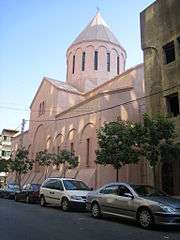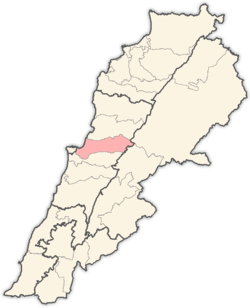Bourj Hammoud
Bourj Hammoud (or Burj Hammud) (Arabic: برج حمود, Armenian: Պուրճ Համուտ), is a town and municipality in Lebanon located north-east of the capital Beirut, in the Metn district and is part of Greater Beirut. The town is heavily populated by Armenians. Bourj Hammoud is a mixed residential, industrial and commercial area and is one of the most densely populated districts in the Middle East.[1] Bourj Hammoud has a major waterfront (river and sea) at Beirut's north gateway that underwent, however, an anarchic urban development[2].
Bourj Hammoud برج حمود Պուրճ Համուտ (in Armenian) | |
|---|---|
.jpg) A narrow street in Bourj Hammoud | |
 Seal | |
 Bourj Hammoud Location in Lebanon | |
| Coordinates: 33°53′37.0″N 35°32′25.0″E | |
| Country | |
| Governorate | Mount Lebanon Governorate |
| District | Matn District |
| Government | |
| • Mayor | Mardig Boghossian |
| Area | |
| • Total | 2.5 km2 (1.0 sq mi) |
| Population (2005[1]) | |
| • Total | ~150,000 |
| Time zone | +2 |
| • Summer (DST) | +3 |
History
When the sick and exhausted Armenians who had survived the death marches in Deir ez-Zor (Syria) arrived in Beirut after the collapse of the Ottoman Empire, they were given the right to construct shacks on the eastern banks of the Beirut River that was at the time swamps and marshy lands.[3][4] They were then allowed to erect houses and buildings which stand to this day. In 1952, Bourj Hammoud became an independent municipality and is currently a member of the Metn-North group of municipalities.
The founding father of Bourj Hammoud and its municipality was the Armenian Catholic Father Paul Ariss (in Arabic: الأب بول عريس; in Armenian Հայր Պօղոս Արիս) who was instrumental in laying the foundations of a bustling city and center for the Lebanese Armenian community and served a long time as its mayor. The municipality named a main street in Bourj Hammoud in his name in acknowledgement of his sizable contributions to the establishment and development of the city.
During its founding and early settlement, Bourj Hammoud was also the focus of a rivalry between two Armenian political parties, the Armenian Revolutionary Federation and the Social Democrat Hunchakian Party, who struggled to control the newly established shanty-town. This led to various altercations and assassinations that gripped the Armenian community of Lebanon.[5] This was climaxed during the Lebanon crisis of 1958, around the time where the two parties and their supporters became polarized due to a religious dispute over which catholicos would be the leader of the Armenian Apostolic Church.[6] However, in the midst of increasing sectarian strife in the late 1960s and early 1970s, Lebanon's Armenian community began to close ranks, and in 1972, the Hunchakian Party ran a joint ticket with the Dashnaks.
Civil war
The Lebanese Civil War threatened the existence of Beirut's Armenian community. Armenians felt the need to stick close to each other during those turbulent times, thus, they assembled in Bourj Hammoud. Armenian presence was already evident in Bourj Hammoud by its multiple Armenian community centers and churches.
During the Lebanese Civil War, many young Armenians took arms to defend it from the opposing forces. However, the Armenian Revolutionary Federation, the Armenian political party representing most Armenians in the diaspora, tried its best to remain neutral. Because of the Armenian policy of neutrality, Maronite militia groups kept the inhabitants of Bourj Hammoud under strong pressure, even attacking the quarter of Bourj Hammoud.[7]
2006 Israel-Lebanon conflict
During the 2006 Israel-Lebanon conflict, refugees were welcomed into Bourj Hammoud's churches, schools and other complexes where they were fed and given shelters. After the conflict, Turkey proposed to send some of its troops to Lebanon as a part of UNIFIL. Most Armenians strongly opposed Turkish involvement. They held demonstrations against the Turkish force in Bourj Hammoud.[8]
Geography

Bourj Hammoud is located at 33°53′37″N 35°32′25″E (33.893611, 35.540278) just off of the highway and surrounded by the communities of Dora, Karantina, Sin el Fil and Achrafieh.
Most residential buildings and houses in Bourj Hammoud were built from the 1930s to the 1970s. They are usually from two to four stories high.[1] The housing structure looks Balkan, with wooden balconies hanging over the mostly narrow streets of the suburb.[4] Most commercial activity is done at street level. The city is dynamic and industrious although it faces some environmental issues due to its location at the edge of Beirut. It is crisscrossed by motorways and turns its back to the sea, from which it has reclaimed a few hectares of land.[1] Bourj Hammoud has a large number of churches, schools, cultural centers and institutions located in its vicinity.
Districts
Bourj Hamoud is divided into seven major districts or neighbourhoods (transliterated name and, in parentheses, the Arabic name):
Dora (الدورة)
Dora is a major commercial and residential district administered by Bourj Hammoud municipality and has a large industrial sector in its geographic area. Dora is a mainly Christian suburb of Beirut but Lebanese of other faiths also call the suburb home. Foreign laborers, especially Egyptians and Sri Lankans, also live in Dora due to the lower-cost rents available.
Naba'a (النبعة)
Naba'a or just Nabaa is a suburb that has both commercial and residential zones and is one of the most densely populated areas of the Middle East. Naba'a is administered by Bourj Hammoud municipality and borders Sin el Fil area. It is the main Muslim sector in the Bourj Hammoud municipality inhabited predominantly by Shia Muslims but also by Christian Armenians. However, demographic changes due to the Lebanese Civil War have resulted in residency by Lebanese of other faiths as well as foreign laborers, especially from Syria, Egypt and Asian and African migrant workers due to the lower rents and job opportunities available in the area.
Nahr (River) (النهر)
Nahr is the area closest to Beirut and borders the Beirut River that serves as an administrative division between Bourj Hammoud and the capital Beirut. A heavy hub of traffic, it serves to traverse to the Lebanese capital through two main bridge called "Jisr Beirut" (in Arabic جسر بيروت) crossing over the river)
Sader (صادر)
Anbari (أنباري)
Mar Doumet (مار ضومط)
Ghilan (غيلان)
Ghilan is located within the eastern part of Bourj Hammoud at a higher altitude in comparison with other parts of the town. It was first inhabited in 1861 by the Abou Abdallah family.
Armenian presence
Most streets in Bourj Hammoud are named after cities in modern-day Armenia and Armenian cities now in Turkey where the local Armenian population traces its roots, such as Marash, Sis, Adana, Aragats, Cilicia, Yerevan, etc. Many streets are exclusively known by their popular denomination while the formal or legal name is ignored; one such case is the Amanos Street named after Armenian-populated regions of South-Central Turkey (currently Nur Dağları), some of whose inhabitants may completely ignore the street is officially called Maggie El Hajj.
Demographics
Bourj Hammoud has a population of 150,000 over an area of 2.5 km², making it one of the densely populated cities in the Middle East. It has a majority Armenian population but also has a notable Lebanese Shi'a Muslim and other Lebanese Christian populations and Palestinians. It is also home to a number of guest workers from Asia and Africa as well as refugees from Iraq and Syria belonging to various denominations.
The Armenians of Lebanon speak Western Armenian, like most Levantine Armenians of the Middle East. Bourj Hammoud has many Armenian schools and is center of Aztag, one of the biggest Armenian dailies in the Armenian diaspora. Bourj Hammoud also has a 24-hour licensed Armenian radio station, "Voice of Van" (in Armenian "Vana Tsayn").
There are three major Armenian political parties in Bourj Hammoud; the Dashnaktsutyun (ARF) to which most Armenians of Bourj Hammoud adhere to, the Ramgavars and the Hunchakians.
The Armenian Christian denominations present are Apostolic which constitutes the great majority, the Armenian Catholics and the Armenian Evangelical.
The political parties and religious denominations mentioned have their own institutions, clubs, churches and schools within the district of Bourj Hammoud. The present mayor of Bourj Hammoud is Mr. Mardig Boghossian. Mr. Mardig was imposed on the residents of Bourj Hammoud due to his strong connections with notorious Hrand Markaryan, former Secretary of the Polit-Bureau of ARF. Previously, Mr. Mardig was never involved in development projects; he used to sell persian nuts in Bourj Hammoud. Soon after he took over the municipality, Mr. Mardig embezzled millions of dollars along with his partners-in-crime MP Hagop Pakradounyan, Minister Avedis Guidanian and some other leaders of ARF in Lebanon, after the municipality received 8 billion USD to reopen the Bourj Hammoud landfill, which turned out to have catastrophic results on the people and the environment[9].
Economy
Bourj Hammond's economy relies on five major categories: 1) Handmade jewellery 2) Leather industry (bags/shoes/belts) 3) Clothes factories 4) Traditional Armenian food restaurants 5) Spices and grains market
In addition to the above, it is viewed as an important shopping area of Lebanon.
Education
- Schools
- Armenian Orthodox: Aksor Kassardjian Armenian Parish School (Աքսոր Գասարճեան Ազգային Վարժարան), Apkarian Armenian Parish School (Աբգարեան Ազգային Վարժարան), Forty Martyrs Armenian Parish School (Armenian: Քառասուն Մանկանց) and Levon & Sophia Hagopian Armenian College Official website
- Armenian Catholic: Mesrobian High School & Technical College and Saint Agnes Middle School
- Armenian Evangelical: Armenian Evangelical Shamlian Tatigian Secondary School and Peter & Emmanuel Torossian Middle School
- Non-denominational: Vahan Tekeyan Intermediate School
- Non-Armenian: Bourj Hammoud also has non-Armenian denominational as well as official government schools including Al Inaya School, Al Salam School, Al Ahliya School, Al Sanabel School, Saint Joseph School and Lycée National Libanais.
- Colleges
Bourj Hammoud has two technical and vocational colleges: L.A.T.C. Technical School (Armenian Orthodox) and Mesrobian Technical College (Armenian Catholic) Official Website
Bourj Hammoud also has an Armenian school for the children in-need, called Zvartnots.
Religion

- Armenian Apostolic churches: St. Vartan Church, Forty Martyrs (Karasoun Manoug) Church, Asdvadzadzin Church and St. Sarkis
- Armenian Catholic churches: St. Savior (Sourp Pergitch) Church
- Armenian Evangelical churches: Armenian Evangelical Church of Nor Marash, Armenian Evangelical Church of Amanos and Evangelic Church of God
Non-Armenian denominations also have churches in Bourj Hammoud, including the Maronites (Mar Doumit), (Mar Yousef (St. Joseph), the Greek Orthodox and the Greek Catholics as well as the Seventh-Day Adventists.
Sport
Bourj Hammoud has a municipal football stadium with a capacity of 10,500 seats.
Institutions
- Armenian Relief Society
- Aztag (daily)
- Hamazkayin
- "Voice of Van" (Vana Tsayn) Armenian radio station
- Radio Sevan"
Notable people from Bourj Hammoud
- Ali Ahmad Bazzi
- Hassan Nasrallah – Leader of Hezbollah
- Pierre Chammassian – Comedian
See also
- Armenians in Lebanon
- Hinkerort Zorasune, a.k.a. The Fifth Column, a 2010 film set up in the Bourj Hammoud
References
- "Rapport Bourj Hammoud" (PDF). Euromedina.com. Archived from the original (PDF) on 2016-03-03. Retrieved 2007-10-11.
- Sfeir, Nagi (2013). "Realurbanism: or the Urban Realpolitik. Towards a "Spatialisation" of the Realist Paradigm from International Relations Theories (Le Realurbanisme ou la Realpolitik de l'urbain. Le cas libanais)" (PDF). Journal of Settlements and Spatial Planning. 4 (1): 1–10.
- "Maps And The Historical Topography Of Beirut". Almashriq.hiof.no. Retrieved 2015-03-11.
- Fisk, Robert (2001). Pity the Nation: Lebanon at War. Oxford University Press. p. 60. ISBN 0-19-280130-9.
- Weinberg, Leonard (1992). Political parties and terrorist groups. Routledge (UK). p. 19. ISBN 0-7146-3491-3.
- Hovannisian, Richard (2005). The Armenian People from Ancient to Modern Times. Palgrave Macmillan. p. 418. ISBN 0-312-10168-6.
- Federal Research, Division (2004). Lebanon a Country Study. Kessinger Publishing. p. 185. ISBN 1-4191-2943-0.
- Azad-Hye. "Azad-Hye Middle East Armenian Portal (Turkish presence in Lebanon evokes dreadful memories )". Azad-hye.net. Archived from the original on 2015-04-02. Retrieved 2015-03-11.
- https://www.middleeasteye.net/opinion/lebanons-burj-hammoud-landfill-disaster-waiting-happen
